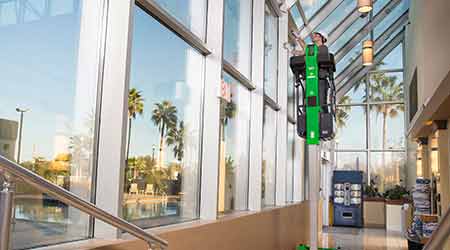 Managers looking to ensure the safety of technicians using aerial work platforms need to stay in constant communication with their safety directors and be attentive to accident and incident reporting.Photo: Sunbelt Rentals
Managers looking to ensure the safety of technicians using aerial work platforms need to stay in constant communication with their safety directors and be attentive to accident and incident reporting.Photo: Sunbelt RentalsLifts Manufacturers Adapt Designs to Match Facilities' Needs
Part three of a four-part article on aerial work platform safety
Managers and their departments often find that renting an aerial work platform is the most appropriate option for a particular project. One fairly new strategy recently employed by equipment manufacturers is to downsize their lift designs, in part to address needs of occasional users. Studies have shown most jobs fall in the intermediate range of equipment capacity and reach, so this is where manufacturers concentrate their design efforts. When users less frequently operate specialized equipment, they will get it from an equipment rental agent.
Examples might include:
• atrium lifts that reach to and above 100 feet for window cleaning or replacement or leak repair
• a specialized straddle adapter that allows a lift to move between seating rows in a theater to reach the ceiling for lighting replacement, leak repairs, and painting
• articulated boom lift that reaches over a row of trees and down to a building wall for grinding and pointing eroded masonry in brickwork.
When selecting a rental agent, managers should consider using a full-service agency that provides a full range of services, such as: manufacturer-certified equipment in original-equipment condition with all features and safety devices functional; both basic and equipment-specific training; training materials if the training is done by the user organization; train-the-trainer courses; operating and maintenance manuals; insurance against theft, tire damage, and other losses; and liability and workers compensation if the agent supplies operators or delivers, unloads and loads the equipment or trains on site.
Regulations require technicians working on a site using an aerial work platform to have proof of training. The International Powered Access Federation offers one such proof: the Powered Access License card, which is a picture identification showing the type of training the holder is certified in, the specific equipment covered, and the date last certified.
The holder must renew the card every five years and keep a log and a minimum of actual experience for updated training. Otherwise, the complete training course is required before re-certification. This identification is particularly useful for verification when operators accompany rented equipment or are unfamiliar to the work site’s owners and to managers.
Related Topics:











